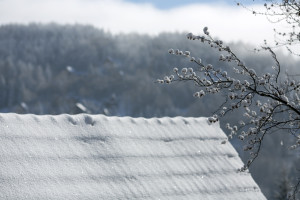It’s no secret that winter can be rough on homes and commercial structures. From cold weather, to freeze/thaw cycles, to ice and snow damage, the winter months are often a test for any building.
And they aren’t getting any easier.
Case in point: Boston set a new record for winter snowfall with 110.6 total inches during the 2014-2015 season, thanks in large part to a series of winter storms that buried the city under more than six feet of snow over the course of six weeks in January and February. For the sake of comparison, the average seasonal snow for the city is just over 43 inches per year.
It was hard on the city itself, which paid more than $30 million to deal with snow removal and remediation in the wake of the storms, but it was hard on local homeowners as well, many of whom emerged from the winter of 2015 with damage to their houses related to ice dams, flooding and moisture intrusion. According to insurance advisory firm Aon Benfield, total economic losses related to winter weather in the U.S. for just the month of January 2015 were estimated to be as much as $500 million.
“The majority of these claims are water damage from ice dams and, to a lesser extent, collapses,” Liberty Mutual spokesperson Glenn Greenberg told industry publication Insurance Journal that spring, indicating just a couple of the ways that ice and snow can wreak havoc on structures.
And that’s just one example of a particularly bad year. The economic damage caused by winter storms is widespread even in typical years. According to insurer Munich Re, winter storms caused about $2.3 billion worth of insured losses in the U.S. in 2014, up from $1.9 billion in 2013. In fact, winter storm losses averaged about $1 billion per year in this country through much of the 1990s and early 2000s. The fact that more people now carry coverage for this type of damage, coupled with the increasingly harsh winters we’re seeing, have contributed to the increase.
So what can homeowners do to protect their properties before winter weather hits?
Sprinklers: The first hard freeze of the year can and will wreak havoc on an in-ground sprinkler system that still has water in it when the ground freezes. Components can snap, lines can break and all sorts of damage can happen in a very short period of time. Protect against this by properly clearing out your sprinkler system every fall—either by draining it or blowing it out with compressed air—and shutting off the water for the winter.
Gutters: It is important to clean out your gutters every fall, removing any leaves or debris that might block the free flow of water through your drainage system. This will prevent water buildup in the gutters and help keep them from freezing once the temperatures dip. It is also a good idea to install gutter guards to prevent debris buildup for the same reason.
Foliage: Make sure to trim the trees on your property to remove any dead or overhanging branches that might break off and damage your home or car when weighed down by ice and snow.
Hard Surfaces: Take the time to seal and repair any cracks in outside walls and foundation surfaces, as well as walkways and drainage areas, anywhere that water might be able to gain access to your home. This also helps to keep cold air out throughout the winter, lowering your energy costs.
Furnace: It is always a good idea to have your heating system serviced every fall, depending on how old it is and what type of furnace you have. This includes an inspection and cleaning of the chimney as well, in order to prevent fires, carbon monoxide buildup and indoor smoke damage.
Plumbing: Always keep an eye on your pipes in the winter to ensure that they do not freeze during particularly cold periods and, if they do, that they are properly thawed so as to minimize leaks and additional damage. Before winter, visually inspect your plumbing lines for any cracks and pinhole leaks that may have formed and make any needed repairs immediately. Exposed pipes should be protected with insulating sleeves or heating cables to prevent freezing, and it’s a good idea to beef up your attic, basement and crawl space insulation layers while you’re at it.


